Senegalia nigrescens
Senegalia nigrescens (Oliv.) P.J.H. Hurter
Family: Fabaceae
Common names: knob thorn (Eng.); knoppiesdoring (Afr.); muunga (Tshivenda); mooka (Sepedi); umKhaya (Zulu)
Introduction
Senegalia nigrescens is a deciduous, small to medium-sized tree which occurs in various savanna regions, often at low altitudes, and in rocky areas, on well drained soil. It is drought- and termite-resistant.
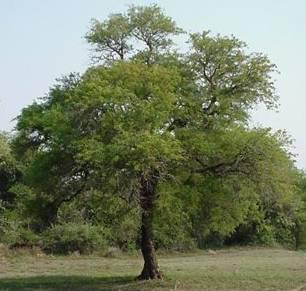
Description
Description
The knob thorn is a deciduous tree that grows 5-18 m in height, with a long cylindrical shape and rounded crown. It has knobs on the trunks and on branches with persistent thorns arising on the knobs.
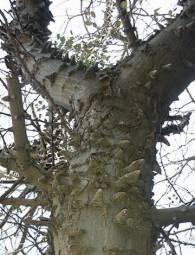
The trunk is approximately 0.5 m in diameter on mature specimens but can reach 0.75 m. Thorns are in pairs below the leaves. The leaf consists of 2 or3 pairs of pinnae (primary divisions of a compound leaf) with 1 or 2 pairs of leaflets per pinna.
Flowers are yellowish white in elongated spikes during Aug.-Nov. They appear before or with the new leaves making the tree very conspicuous. Fruit are dark brown, thinly textured pods borne in pendant (hanging downward) clusters.
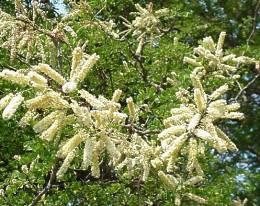
Conservation Status
Status
Acacia nigrescens is listed in the 2009 Red Data Listing (Raimondo et al. 2009) but has no threat status.
Distribution and habitat
Distribution description
Knob thorn is a species with a wide distribution range, occurring from Tanzania southwards to KwaZulu-Natal, often on deep, sandy soils and commonly in widely-spaced stands. It is a familiar sight to visitors to the Kruger National Park.
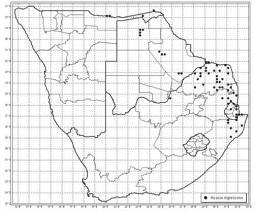
Derivation of name and historical aspects
History
This tree was previously called Acacia nigrescens. Acacia is derived from the Greek name "akakia". It was named Acacia in the16th century with the Latin form "acacia" meaning thorny tree. Nigrescens: 'becoming black', is thought to refer to either the colour of the thorns or the pods. Its common names in English and Afrikaans refer to the very characteristic thorns borne on knobs on the stem. The genus name Senegalia is derived from the name of the African country, Senegal.
Ecology
Ecology
Senegalia nigrescens flowers are a dietary component for giraffes. Its flowers contain almost three times as much condensed tannin as leaves. Giraffes consume large quantities of flowers resulting in distinct browse lines on the trees.
Uses
Use
Knob thorn trees are the host of hole-nesting bird species and the larvae of the dusky charaxes butterfly. The wood is hard and drought- and termite-resistant but frost-tender; it has been used to make fence posts and mine props. The knob thorn yields good quality firewood producing lasting coals and severe heat. It also makes a good bonsai subject. It is not regularly used for furniture because it is difficult to cut. Knob thorn leaves and pods are included in the diet of elephant, giraffe, kudu, duiker, impala and steenbok.
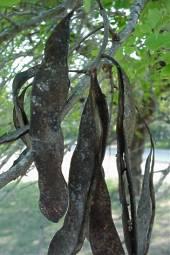
Growing Senegalia nigrescens
Grow
Senegalia nigrescens is an attractive garden tree which grows into a lovely shade tree. It can be cultivated from seed soaked in hot water and left overnight. Then it can be planted in separate plastic bags the following day. When a seedling develops a taproot, it must be planted in a larger bag. Seedlings are easily transplanted.
References
- Coates Palgrave, M. 2002. Keith Coates Palgrave Trees of southern Africa, edn 3. Struik, Cape Town.
- Grant, R. & Thomas, V.1999. Sappi tree spotting, Tree identification made easy. KwaZulu-Natal coast and Midlands. Jacana, Johannesburg.
- Palmer, E. & Pitman, N. 1972. Trees of southern Africa. Balkema, Cape Town.Van Wyk, Braam, A.E.& Van Wyk, P. 1997. Field guide to trees of southern Africa. Struik Publishers, Cape Town.
- Raimondo, D., Von Staden, L., Foden, W., Victor, J.E., Helme, N.A., Turner, R.C., Kamundi, D.A. & Manyama, P.A. (eds) 2009. Red List of South African plants. Strelitzia 25.South African National Biodiversity Institute, Pretoria.
- Van Wyk, B-E. & Gericke, N. 2000. People's plants. A guide to useful plants of southern Africa. Briza Publications, Pretoria.
- Von Breitenbach, J., De Winter, B., Poyton, R., Van der Berg, E., Van Wyk, B. & Van Wyk, E. 2001. Pocket list of Southern African indigenous trees.
- Kyalangalilwa B, et al. 2013. Phylogenetic position and revised classification of acacia s.l.(Fabaceae Mimosoideae) in Africa, including new combinations of Vachellia and Senegalia. Botanical Journal of Linnean Society 172,500-523.
Credits
Thabo Masupa
National Herbarium, Pretoria
September 2011
Plant Attributes:
Plant Type: Tree
SA Distribution: Gauteng, KwaZulu-Natal, Limpopo, Mpumalanga, North West
Soil type: Sandy, Loam
Flowering season: Spring
PH: Neutral
Flower colour: White, Cream, Yellow
Aspect: Full Sun
Gardening skill: Easy
Special Features:
Horticultural zones









Rate this article
Article well written and informative
Rate this plant
Is this an interesting plant?
Login to add your Comment
Back to topNot registered yet? Click here to register.